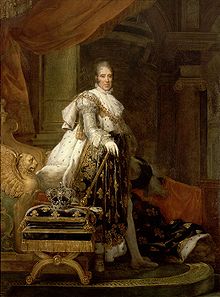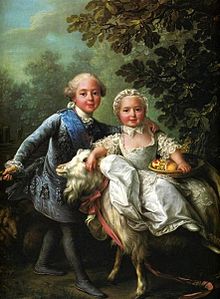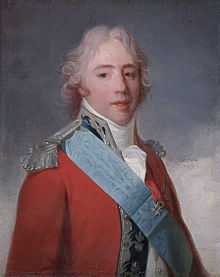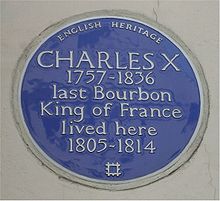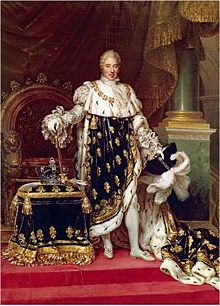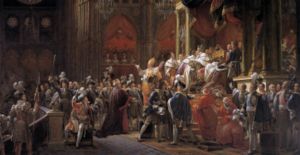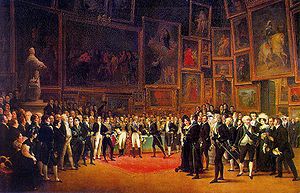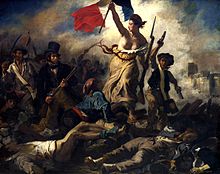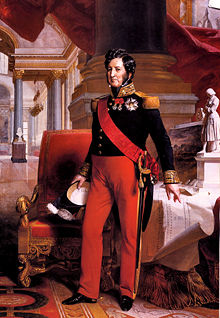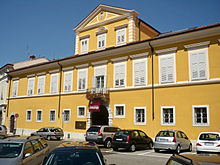- Charles X of France
-
- "Charles X" redirects here. For the King of Sweden, see Charles X Gustav of Sweden, for the Catholic claimant of 1589, see Charles, Cardinal de Bourbon.
Charles X King Charles X
by François Pascal Simon Gérard, 1825.King of France and of Navarre Reign 16 September 1824 – 2 August 1830 (5 years, 320 days) Coronation 28 May 1825 (aged 67) Predecessor Louis XVIII Successor Louis Philippe I
as King of the FrenchSpouse Marie Thérèse of Savoy Issue Louis Antoine, Duke of Angoulême
Charles Ferdinand, Duke of BerryFull name Charles Philippe de France House Bourbon Father Louis, Dauphin of France Mother Marie Josèphe of Saxony Born 9 October 1757
Palace of Versailles, FranceDied 6 November 1836 (aged 79)
Gorizia, Austrian Empire (now in Italy)Burial Kostanjevica Monastery, Nova Gorica, Slovenia Charles X (Charles Philippe; 9 October 1757 – 6 November 1836) was known for most of his life as the Comte d'Artois before he reigned as King of France and of Navarre from 16 September 1824 until 2 August 1830.[1] A younger brother to Kings Louis XVI and Louis XVIII, he supported the latter in exile and eventually succeeded him. His rule of almost six years ended in the July Revolution of 1830, which frustrated his attempts to keep the crown in the senior branch of the House of Bourbon and resulted in the election of Louis Philippe, Duke of Orléans, as King of the French. Exiled once again, Charles died in Gorizia, then part of the Austrian Empire.[2]
Contents
Childhood and adolescence
Charles Philippe of France was born in 1757, the youngest son of the Dauphin Louis and his wife, the Dauphine Marie Josèphe, at the Palace of Versailles. Charles was created "Count of Artois" at birth by his grandfather, the reigning King Louis XV.[3] As the youngest male in the family, Charles seemed unlikely ever to become king. His eldest brother, Louis, Duke of Burgundy, died unexpectedly in 1761, which moved Charles up one place in the line of succession. He was raised by Madame de Marsan, the Governess of the Children of France.
At the death of his father in 1765, Charles's oldest surviving brother, Louis Auguste, became the new Dauphin (the heir-apparent to the French throne). Their mother Marie Josèphe, who never recovered from the loss of her husband, died in March 1767 from tuberculosis.[4] This left Charles an orphan at the age of nine, along with his siblings Louis Auguste, Louis Stanislas, Count of Provence, Clotilde ("Madame Clotilde"), and Élisabeth, ("Madame Élisabeth").
Louis XV fell ill on 27 April 1774 and died on 10 May of smallpox at the age of 64.[5] His grandson Louis-Auguste succeeded him as King Louis XVI of France. The king, his brothers and Marie Antoinette became fellows of the masonic lodge Trois Frères à l'Orient de Versailles.[6]
Marriage and private life
In November 1773, Charles married Marie Thérèse of Savoy. The marriage, unlike that of Marie Antoinette and Louis-Auguste, was consummated almost immediately.[7]
In 1775, Marie Thérèse gave birth to a boy, Louis Antoine, who was created Duke of Angoulême by Louis XVI. Louis-Antoine was the first of the next generation of Bourbons, as the King and the Count of Provence had not fathered any children yet, causing the Parisian libellistes (pamphleteers who published scandalous leaflets about important figures in court and politics) to lampoon Louis XVI's alleged impotence.[8] Three years later, in 1778, Charles's second son, Charles Ferdinand, was born and was given the title of a Duke of Berry.[9] In the same year Queen Marie Antoinette gave birth to her first child, Marie Thérèse, quelling all rumours that she could not bear children.
Charles was thought of as the most attractive in his family, bearing a strong resemblance to his grandfather, Louis XV.[10] As his wife was considered quite ugly by most contemporaries, he looked for company elsewhere. Accordingly, his extramarital affairs became numerous. According to the Count of Hezecques, "few beauties were cruel to him." Later, he embarked upon a life-long love affair with the beautiful Louise de Polastron (1764–1804), the sister-in-law of Marie Antoinette's closest companion, the Duchess of Polignac.
Charles also struck up a firm friendship with his sister-in-law, Queen Marie Antoinette, whom he had first met at her arrival in France in April 1770 when he was twelve.[10] The closeness of the relationship was such that he was falsely accused by Parisian rumour mongers of having seduced Marie Antoinette. As part of Marie Antoinette's social set, Charles often appeared opposite her in the private theatre of her favourite royal retreat, the Petit Trianon. They were both said to be very talented amateur actors; with Marie Antoinette playing milkmaids, shepherdesses and country ladies, and Charles playing lovers, valets and farmers.
A famous story concerning the two involves the construction of the Château de Bagatelle. In 1775, Charles purchased a small hunting lodge in the Bois de Boulogne. He soon had the existing house torn down with plans to rebuild. Marie Antoinette wagered her brother-in-law that the new château could not be completed within three months. Charles engaged the neoclassical architect François-Joseph Bélanger to design the building. He won his bet, with Bélanger completing the house in sixty-three days. It is estimated that the project, which came to include manicured gardens, cost over two million livres. Throughout the 1770s, Charles spent lavishly. He accumulated enormous debts, totalling 21 million livres. In the 1780s, King Louis XVI paid off the debts of both his brothers, the Counts of Provence and Artois.[11]
Also around 1775, Louis Philippe d'Orléans, the future Duke of Orléans, schemed to create a rift between the King and his youngest brother. Louis Philippe introduced Charles to gambling and the brothels at the Palais-Royal, the ancestral home of Louis Philippe's family. Louis Philippe wanted Charles to catch a venereal disease, and either die as a result or become sterile[citation needed], thereby increasing his own chances of one day gaining the throne of France. As first prince of the blood, Louis Philippe would have been fourth in line to the throne after the Counts of Provence, Artois and Angoulême, as Charles was the only member of his family to produce any children so far.[12]
In 1781, Charles acted as a proxy for the Emperor Joseph II at the christening of his godson, the Dauphin Louis Joseph.[13]
Crisis and Revolution
Charles's political awakening started with the first great crisis of the monarchy in 1786, when it became apparent that the kingdom was bankrupt from previous military endeavours (in particular the Seven Years' War and the American War of Independence) and needed fiscal reform to survive. Charles supported the removal of the aristocracy's financial privileges, but was opposed to any reduction in the social privileges enjoyed by either the Church or the nobility. He believed that France's finances should be reformed without the monarchy being overthrown. In his own words, it was "time for repair, not demolition."
King Louis XVI eventually convened the Estates General, which had not been assembled for over 150 years, to meet in May 1789 to ratify financial reforms. Along with his sister "Madame Élisabeth", Charles was the most conservative member of the family[14] and opposed the demands of the Third Estate (representing the commoners) to increase their voting power. This prompted criticism from his brother, who accused him of being "plus royaliste que le roi" ("more royalist than the King"). In June 1789, the represetatives of the Third Estate declared themselves a National Assembly intent on providing France with a new constitution.[15]
In conjunction with the Baron de Breteuil, Charles had political alliances arranged to depose the liberal minister of finance, Jacques Necker. These plans backfired when Charles attempted to secure Necker's dismissal on 11 July without Breteuil's knowledge, much earlier than they had originally intended. It was the beginning of a decline in his political alliance with Breteuil, which ended in mutual loathing.
Necker's dismissal provoked the storming of the Bastille on 14 July. At the insistence of Louis XVI and Marie Antoinette, Charles and his family left France three days later, on 17 July, along with several other courtiers, including Madame de Polignac, the Queen’s favourite.[16]
Life in exile
Charles and his family decided to seek refuge in Savoy, Marie Thérèse's native country,[17] where they were joined by some members of the Condé family.[18]
Meanwhile in Paris, Louis XVI was struggling with the National Assembly, which was committed to radical reforms and had enacted the Constitution of 1791. In March 1791, the Assembly also enacted a regency bill which provided for the case of the King's premature death. While his heir Louis-Charles was still a minor, the Count of Provence, the Duke of Orléans or, if either was unavailable, someone chosen by election should become regent, completely passing over the rights of Charles who, in the royal lineage, stood between the Count of Provence and the Duke of Orléans.[19]
Charles meanwhile left Turin and moved to Trier, where his uncle, Clemens Wenceslaus of Saxony was the incumbent Archbishop-Elector. Charles prepared for a counter-revolutionary invasion of France, but after a letter by Marie Antoinette postponed it to after the royal family had escaped France.[20] After the attempted flight was stopped at Varennes, Charles moved on to Koblenz, where he, the recently escaped Count of Provence and the Princes of Condé jointly declared their intention to invade France. The Count of Provence was sending dispatches to various European sovereigns for assistance, while Charles set up a court-in-exile in the Electorate of Trier. On 25 August, the rulers of Austria and Prussia issued the Declaration of Pillnitz, which called on other European powers to intervene in France.[21]
On New Year's Day 1792, the National Assembly declared all emigrants traitors, repudiated their titles and confiscated their lands.[22] This measure was followed by the suspension and eventually the abolition of the monarchy in September 1792. The royal family was imprisoned in the Temple, and eventually put to death[23] or, as in the case of the young Dauphin died of illnesses and neglect.[24]
When the French Revolutionary Wars broke out in 1792, Charles escaped to Great Britain, where King George III of Great Britain gave him a generous allowance. Charles lived in Edinburgh and London with his mistress Louise de Polastron[25] His older brother, dubbed Louis XVIII after the death of his nephew in June 1795, relocated to Verona and then to Jelgava Palace, Mitau, where Charles's son, Louis Antoine, married Louis XVI's only surviving child, Marie Thérèse on 10 June 1799. In 1802, Charles supported his brother with several thousand pounds. In 1807, Louis XVIII moved to Great Britain.[26]
The Bourbon Restoration
In January 1814, Charles covertly left his home in London to join the Coalition forces in southern France. Louis XVIII, by then wheelchair-bound, supplied Charles with letters patent creating him Lieutenant General of the Kingdom. On 31 March, the Allies captured Paris. A week later Napoleon I abdicated. The Senate declared Louis XVIII restored. Charles arrived in the capital on 12 April[27] and acted as Lieutenant General of the Kingdom until Louis XVIII arrived from England. During his brief tenure as regent, Charles created an ultra-royalist secret police, that reported directly back to him without Louis XVIII's knowledge. It operated for over five years.[28]
Louis XVIII was greeted with great rejoicing from the Parisians and proceeded to occupy the Tuileries Palace.[29] His brother, the Count of Artois, lived in the Pavillon de Mars, the Duke of Angoulême in the Pavillon de Flore, which overlooked the River Seine.[30] The Duchess of Angoulême fainted upon arriving at the palace, as it brought back terrible memories of her family's incarceration there, and of the storming of the palace and the massacre of the Swiss Guards on 10 August 1792.[29]
Following the advice of the occupying allied army, Louis XVIII drafted a liberal constitution, the Charter of 1814, which entailed a bicameral legislature, an electorate of 90,000 men and freedom of religion.[31]
After the Hundred Days, Napoleon's brief return to power in 1815,[32] the White Terror swept across France, when 80,000 Napoleonic officials and generals were removed from their positions and some even killed, most notably the Marshalls Ney, who was executed for treason, and Brune, who was murdered.[33]
The King's brother and heir
While the King retained the liberal charter, Charles patronised members of the ultra-royalists in parliament, such as Jules de Polignac, the writer François-René de Chateaubriand and Jean-Baptiste de Villèle[34] and on several occasions, Charles voiced his disapproval of his brother's liberal ministries and threatened to leave the country unless Louis XVIII dismissed them.[35] Louis, in turn, feared his brother's and heir-presumptive's ultra-royalist tendencies would send the family into exile once more.
On 14 February 1820, Charles's younger son, the Duke of Berry, was assassinated at the Paris Opera. This loss not only devastated the family but also put the continuation of the Bourbon dynasty in jeopardy, as the Duke of Angoulême's marriage had not produced any children. Parliament debated the abolition of the Salic law, which excluded females from the succession and was long held inviolable. However, the Duke of Berry's widow, Caroline of Naples and Sicily, was found to be pregnant and on 29 September 1820 gave birth to a son, Henri, Duke of Bordeaux.[36] His birth was hailed as "godgiven" and the people of France bought him the Château de Chambord in celebration of his birth.[citation needed]As a result his granduncle, Louis XVIII, added the title Count de Chambord hence Henry Count of Chambord the name by which he is usually known.
Reign
Internal policies
Louis XVIII's health had been worsening since the beginning of 1824.[37] Suffering from both dry and wet gangrene in his legs and spine, he died on 16 September of that year. His brother succeeded him to the throne as King Charles X of France.[38]
In his first act as King, Charles attempted to unify the House of Bourbon by granting the style of Royal Highness to his cousins of the House of Orléans, who had been deprived of this by Louis XVIII because of the former Duke of Orléans' role in the death of Louis XVI.
In the first few months of his reign, Charles's government passed a series of laws that bolstered the power of the nobility and clergy.[clarification needed] Charles gave his Prime Minister, Jean-Baptiste de Villèle, lists of laws that he wanted ratified every time he opened parliament. In April 1825, the government approved legislation, proposed by Louis XVIII but implemented only after his death, that paid an indemnity to nobles whose estates had been confiscated during the Revolution. The law gave government bonds to those who had lost their lands, in exchange for their renunciation of their ownership, costing the state approximately 988 million francs. In the same month, the Anti-Sacrilege Act was passed. Charles's government attempted to re-establish male only primogeniture for families paying over 300 francs in tax, but the measure was voted down in the Chamber of Deputies.[39]
On 29 May 1825, King Charles was anointed at the cathedral of Reims, the traditional site of consecration of French Kings which however had been unused since 1775 as Louis XVIII had foregone the ceremony to avoid controversy.[40]
That Charles was not a popular ruler became apparent in April 1827, when chaos ensued during the King's review of the National Guard. In retaliation, the National Guard was disbanded but, as its members were not disarmed, it remained a potential threat.[40]
After losing his parliamentary majority in a general election in November 1827, Charles dismissed Prime Minister Villèle on 5 January 1828 and appointed Jean-Baptise de Martignac, a man the King disliked and thought of only as provisional. On 5 August 1829, Charles dismissed Martignac and appointed Jules de Polignac, who, however, lost his majority in parliament at the end of August, when the Chateaubriand faction defected. To stay in power, Polignac would not recall the Chambers until March 1830.[41]
Conquest of Algeria
On 31 January 1830, the Polignac government decided to send a military expedition to Algeria to put an end to the threat the Algerian pirates posed to Mediterranean trade and also increase the government's popularity by a victory. The reason given for the war was that the viceroy of Algeria, angry about French failure to pay its debts stemming from Napoleon's invasion of Egypt, had struck the French ambassador with the handle of his fly swat.[41] French troops invaded Algiers on 5 July.[42]
The July Revolution
The Chambers convened on 2 March 1830, as planned, but Charles's opening speech was greeted by negative reactions from many deputies. Some introduced a bill demanding that the King's ministers should have the backing of the Chambers. On 18 March, 221 deputies, a majority by 30, voted in favor of the bill. However, the King had already decided to hold general elections and thus the chamber was suspended on 19 March.[43]
Elections were held on 23 June, but did not produce a majority favorable to the government. Therefore, on 6 July, the King and his ministers decided to suspend the constitution, as provided for by Article 14 of the Charter in case of an emergency, and on 25 July, from his residence in Saint-Cloud, issued four ordinances, known as Ordonnances de Saint-Cloud, which censored the press, dissolved the newly elected chamber, altered the electoral system and called for elections in September.[42]
When the official government newspaper, Le Moniteur Universel, published the ordinances on Monday, 26 July, Adolphe Thiers, journalist at the opposition paper Le National, published a call to revolt, which was signed by forty-three journalists[44]: The legal regime has been interrupted: that of force has begun... Obedience ceases to be a duty![45] In the evening, crowds assembled in the gardens of the Palais-Royal, shouting "Down with the Bourbons!" and "Vive la Charte". As the police closed off the gardens during the nights, the crowd re-grouped in a nearby street, where they shattered the street lamps.[46]
The next morning, 27 July, police raided and shut down the newspapers that continued to publish (including Le National). When the protesters, who had re-entered the Palais-Royal gardens, heard of this, they attacked soldiers with missiles, prompting them to shoot. By the evening, the city was dominated by violence and shops were looted.
On 28 July, the rioters began to erect barricades in streets. Marshal Marmont, who had been called in the day before to remedy the situation, took the offensive against the rioters, but some of his men defected to the rioters and by the afternoon he had to retreat to the Tuileries Palace.[47]
The members of the Chamber of Deputies sent a five-man delegation to Marmont, urging him to advise the King to revoke the ordinances and thus assuage the anger of the protesters. Subsequently, on Marmont's request the prime minister intervened with the King, but Charles refused all compromise and dismissed all of his ministers that afternoon, realizing the precariousness of the situation. That evening, the members of the Chamber assembled at Jacques Laffitte's house and decided that Louis Philippe d'Orléans should take the throne from King Charles. They printed posters endorsing Louis Philippe and distributed them throughout the city. By the end of the day, the government's authority was trampled.[48]
A few minutes after midnight in the early hour of 31 July, warned by General Gresseau that Parisians were scheming to attack the residence, Charles X decided to leave Saint-Cloud and seek refuge in Versailles with his family, and the Court, with the exception of the duc d’Angoulême who stayed behind with the troops, and the duchesse d’Angoulême, who was taking the waters at Vichy. Meanwhile in Paris, Louis Philippe assumed the post of Lieutenant General of the Kingdom.[49]
The road to Versailles was filled with disorganized troops and deserters. The Marquis de Vérac, governor of the Palace of Versailles, came to meet the king before the royal cortège entered the town, to tell him that the palace was not safe, as the Versailles national guards wearing the tricolor were occupying the Place d'Armes. Charles X then gave the order to go to Trianon. It was five in the morning.[50]
Later on in the day, after the arrival of the Duke of Angoulême who had left Saint-Cloud with his troops, Charles X ordered the departure for Rambouillet where they arrived shortly before midnight. In the morning of 1 August, the duchesse d’Angoulême, who had rushed from Vichy after learning of the events, arrived at Rambouillet.
The following day, 2 August, bypassing his son the Dauphin, Charles X abdicated in favor of his grandson, Henri, Duke of Bordeaux, who was not yet ten years old. At first, the Duke of Angoulême refused to countersign the document by which he was made to renounce his rights to the throne of France. According to the Duchess of Maillé, “there was a strong altercation between the father and the son. We could hear their voices in the next room.” Finally, after twenty minutes, the Duke of Angoulême reluctantly countersigned the (following) document.[51]
“My cousin, I am too deeply pained by the ills that afflict or could threaten my people for not having found the means to avoid them. Therefore, I have taken the resolution to abdicate the crown in favor of my grandson, the Duke of Bordeaux. The Dauphin, who shares my feelings, also renounces his rights in favor of his nephew. Therefore, you will have, within your power as Lieutenant General of the Kingdom, to proclaim the accession of Henri V to the throne. Furthermore, you will take all the measures that concern you in order to set up the forms of government during the new king’s minority. Here, I only want my dispositions to be known: it is a means to avoid further ills. You will communicate my intentions to the diplomatic corps, and you will let me know as soon as possible the proclamation by which my grandson will be recognised as king under the name of Henri V.”
Louis Philippe ignored the document and on 9 August had himself proclaimed King of the French by the members of the Chamber.[53]
Second exile and death
When it became apparent that a mob of 14,000 people was preparing to attack, the royal family was forced to leave Rambouillet and, on 16 August, embarked on packet steamers provided by Louis Philippe, to the United Kingdom. Informed by the British Prime Minister, the Duke of Wellington, that they needed to arrive in England as private citizens, all adopted pseudonyms, with Charles X assuming the name of a "Count of Ponthieu". The Bourbons were greeted coldly by the English, who upon their arrival mockingly waved the newly adopted tri-colour flags at them.[54]
Charles X was quickly followed to Britain by his creditors, who had lent him vast sums during his first exile and were yet to be paid back in full. However, the family could use money Charles's wife had stocked away in London.[54]
The Bourbons were allowed to reside in Lulworth Castle in Dorset, but quickly moved to Holyrood Palace in Edinburgh,[54] where the Duchess of Berry also lived at Regent Terrace[55]
Charles's relationship with his daughter-in-law proved uneasy, as the Duchess claimed the regency for her son, Henri, whom the abdications of Rambouillet had left the legitimist pretender to the French throne. Charles at first denied her demands, but in December acquiesced,[56] and only once she had landed in France.[55] Soon afterwards, the Duchess by way of the Netherlands, Prussia and Austria made her way to her Italian relatives.[55] Finding little support there, she arrived in Marseilles in April,[55] made her way to the Vendée, where she tried to instigate an uprising against the new regime, and was imprisoned, much to the embarrassment of her father-in-law.[56] He was further dismayed when after her release the Duchess married the Count of Lucchesi Palli, a minor Neapolitan noble. As a result of this morganatic match, Charles banned her from seeing her children.[57]
On the invitation of Emperor Francis I of Austria, the Bourbons moved to Prague in winter 1832/33 and were given lodging at the Hradschin Palace by the Emperor.[56] In September 1833, Bourbon legitimists gathered in Prague to celebrate the Duke of Bordeaux's thirteenth birthday. They expected grand celebrations but Charles X merely proclaimed his grandson's majority. On the same day, after much cajoling by Chateaubriand, Charles agreed to a meeting with his daughter-in-law, which took place in Leoben on 13 October 1833. The children of the Duchess refused to meet with her after they had learnt of her second marriage. Charles refused the various demands by the Duchess, but after protests from his other daughter-in-law, the Duchess of Angoulême, gave in again. In the summer of 1834, he again allowed the Duchess of Berry to see her children.[58]
Upon the death of Emperor Francis in March 1835, the Bourbons left Prague Castle as the new Emperor Ferdinand wished to use it for his coronation. The Bourbons first moved to Teplitz, but as Ferdinand wanted to use Prague Castle on a more permanent basis, they purchased Kirchberg Castle. Moving there was postponed due to an outbreak of cholera in the locality. In the meantime, Charles left for the warmer climate on Austria's Mediterranean coast in October 1835. Upon his arrival at Gorizia he caught cholera and died on 6 November 1836. The townspeople draped their windows in black to mourn him. Charles was interred in the Church of the Annunciation of Our Lady, in the Franciscan Kostanjevica Monastery (now in Nova Gorica, Slovenia).[59]
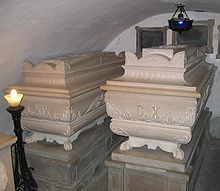 Tombs of Charles X and his son Louis at the Kostanjevica Monastery in the Slovenian town of Nova Gorica
Tombs of Charles X and his son Louis at the Kostanjevica Monastery in the Slovenian town of Nova Gorica
The remains of Charles X are in a crypt with that of the other members of the exiled French Royal Family. Above his sarcophagus, made of marble, there is a black stone on which is inscribed:
Ici repose très haut et très puissant excellent prince Charles X de nom roi, par la grâce de Dieu, de France et de Navarre
("Here lies very high and powerful excellent prince Charles X by name king, by the grace of God, of France and of Navarre")
Ancestry
Ancestors of Charles X of France 16. Louis, Dauphin of France 8. Louis, Dauphin of France and Duke of Burgundy 17. Maria Anna of Bavaria 4. Louis XV of France 18. Victor Amadeus II of Sardinia 9. Marie Adélaïde of Savoy 19. Anne Marie d'Orléans 2. Louis, Dauphin of France 20. Rafał Leszczyński 10. Stanisław Leszczyński 21. Anna Jabłonowska 5. Marie Leszczyńska 22. Jan Karol Opaliński 11. Katarzyna Opalińska 23. Zofia Czarnkowska 1. Charles X of France 24. John George III, Elector of Saxony 12. Augustus II of Poland 25. Anne Sophie of Denmark 6. Augustus III of Poland 26. Christian Ernst, Margrave of Brandenburg-Bayreuth 13. Christiane Eberhardine of Brandenburg-Bayreuth 27. Sophie Luise of Württemberg 3. Marie Josèphe of Saxony 28. Leopold I, Holy Roman Emperor 14. Joseph I, Holy Roman Emperor 29. Eleonore-Magdalena of Neuburg 7. Maria Josepha of Austria 30. John Frederick, Duke of Brunswick-Lüneburg 15. Wilhelmina Amalia of Brunswick 31. Benedicta Henrietta of the Palatinate Marriage and issue
Charles X married Princess Maria Teresa of Savoy, the daughter of Victor Amadeus III, King of Sardinia and Maria Antonietta of Spain, on 16 November 1773. The couple had four children:
- Louis Antoine, Duke of Angoulême (6 August 1775 – 3 June 1844) Louis Antoine d'Artois
- Sophie (5 August 1776 – 5 December 1783) Sophie d'Artois
- Charles Ferdinand, Duke of Berry (24 January 1778 – 13 February 1820) Charles Ferdinand d'Artois
- Marie Thérèse (1783) Marie Thérèse d'Artois
References
- ^ Mary Platt Parmele, A Short History of France. New York: Charles Scribner's Sons (1894), p. 221.
- ^ Munro Price, The Perilous Crown: France between Revolutions, Macmillan, p. 185-187.
- ^ nndb.com
- ^ Évelyne Lever, Louis XVI, Librairie Arthème Fayard, Paris (1985), p. 43
- ^ Antonia Fraser, Marie Antoinette: the Journey, p. 113–116.
- ^ Charles Porset, Hiram sans-culotte? Franc-maçonnerie, lumières et révolution: trente ans d'études et de recherches, Paris: Honoré Champion, 1998 p. 207.
- ^ Fraser, p. 128-129.
- ^ Fraser, p. 137–139.
- ^ Fraser, p. 189.
- ^ a b Fraser, p. 80-81.
- ^ Fraser, p. 178.
- ^ Susan Nagel, Marie Thérèse: Child of Terror, p. 11-12.
- ^ Fraser, p. 221.
- ^ Fraser, p. 326.
- ^ Fraser, p. 274–278.
- ^ Fraser, p. 338.
- ^ Fraser, p. 340.
- ^ Nagel, p. 65.
- ^ Fraser, p. 383.
- ^ Nagel, p. 103.
- ^ Nagel, p. 113.
- ^ Nagel, p. 118.
- ^ Fraser, p. 399, 440, 456; Nagel, p. 143.
- ^ Nagel, p. 152-153.
- ^ Nagel, p. 207.
- ^ Nagel, p. 210, 222, 233–235
- ^ Nagel, p. 153.
- ^ Price, p. 11-12.
- ^ a b Nagel, p. 253-254.
- ^ Price, p. 50.
- ^ Price, p. 52-54.
- ^ Price, p. 72, 80–83
- ^ Price, p. 84.
- ^ Price, p. 91-92.
- ^ Price, p. 94-95.
- ^ Price, p. 109.
- ^ Lever, Évelyne, Louis XVIII, Librairie Arthème Fayard, Paris, 1988, p. 553. (French).
- ^ Price, p. 113-115.
- ^ Price, p. 116-118.
- ^ a b Price, p. 119-121.
- ^ a b Price, p. 122-128.
- ^ a b Price, p. 136-138.
- ^ Price, p. 130-132.
- ^ Castelot, André, Charles X, Librairie Académique Perrin, Paris, 1988, p. 454 ISBN 2-262-00545-1
- ^ Le régime légal est interrompu; celui de la force a commencé... L'obéissance cesse d'être un devoir!
- ^ Price, p. 141-142.
- ^ Price, p. 151-154, 157.
- ^ Price, p. 158, 161–163.
- ^ Price, p. 173-176.
- ^ Castelot, Charles X, p. 482.
- ^ Castelot, Charles X, p. 491
- ^ Charles X's abdication: “Mon cousin, je suis trop profondément peiné des maux qui affligent ou qui pourraient menacer mes peuples pour n’avoir pas cherché un moyen de les prévenir. J’ai donc pris la résolution d’abdiquer la couronne en faveur de mon petit-fils, le duc de Bordeaux. Le dauphin, qui partage mes sentiments, renonce aussi à ses droits en faveur de son neveu. Vous aurez donc, en votre qualité de lieutenant général du royaume, à faire proclamer l’avènement de Henri V à la couronne. Vous prendrez d’ailleurs toutes les mesures qui vous concernent pour régler les formes du gouvernement pendant la minorité du nouveau roi. Ici, je me borne à faire connaître ces dispositions : c’est un moyen d’éviter encore bien des maux. Vous communiquerez mes intentions au corps diplomatique, et vous me ferez connaître le plus tôt possible la proclamation par laquelle mon petit-fils sera reconnu roi sous le nom de Henri V. »
- ^ Price, p. 177, 181–182, 185.
- ^ a b c Nagel, p. 318-325
- ^ a b c d A.J. Mackenzie-Stuart, A French King at Holyrood, Edinburgh (1995).
- ^ a b c Nagel, p. 327-328.
- ^ Nagel, pp. 322, 333.
- ^ Nagel, p. 340-342.
- ^ Nagel, p. 349-350.
- ^ Castelot, Charles X, p. 577
External links
 Media related to Charles X of France at Wikimedia CommonsCharles X of FranceBorn: 9 October 1757 Died: 6 November 1836
Media related to Charles X of France at Wikimedia CommonsCharles X of FranceBorn: 9 October 1757 Died: 6 November 1836Regnal titles Preceded by
Louis XVIIIKing of France and Navarre
16 September 1824 – 2 August 1830Succeeded by
Louis-Philippe,
as King of the FrenchFrench royalty Preceded by
Napoleon Francis, King of RomeHeir to the Throne
as Heir presumptive
4 June 1814 – 16 September 1824Succeeded by
Louis-Antoine, Duke of AngoulêmeTitles in pretence Vacant Title last held byLouis XVIII— TITULAR —
King of France and Navarre
Legitimist pretender to the French throne
9 August 1830 – 6 November 1836
Reason for succession failure:
July RevolutionSucceeded by
Louis XIXPrinces of France The first generation are the children of Henri IV; these males held the rank of Son of France or Grand son of France;1st Generation 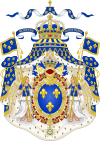
2nd Generation 3rd Generation Louis, Dauphin of France · Philippe Charles, Duke of Anjou* · Louis François, Duke of Anjou* · Philippe Charles, Duke of Valois* · Alexandre Louis, Duke of Valois* · Philippe, Duke of Orléans4th Generation 5th Generation 6th Generation Louis, Dauphin of France · Philippe, Duke of Anjou*7th Generation 8th Generation Louis Joseph, Dauphin of France* · Louis XVII* · Louis Antoine, Duke of Angoulême* · Charles Ferdinand, Duke of Berry*died without surviving issueList of French monarchs Merovingians
(481–751)Clovis Ist (481–511) • Chlothar I (511–561) • Charibert I (561–567) • Guntram (561–593) • Chilperic I (561–584) • Sigebert I (561–575) • Chlothar II (584–629) • Dagobert I (629–639) • Sigebert II (639–656) • Clovis II (639–657) • Chlothar III (657–673) • Theuderic III (673–691) • Clovis III (691–695) • Childebert III (695–711) • Dagobert III (711–715) • Chilperic II (715–721) • Chlothar IV (717–719) • Thierry IV (721–737) • Childeric III (737–751)Carolingians
(843–888, 898–922, 936–987)Pepin III (751–768) • Carloman I (768–771) • Charlemagne (768–814) • Louis I (814–840) • Charles I (843–877) • Louis II (877–879) • Louis III (879–882) • Carloman II (879–884) • Charles II (885–888) • Charles III (898–922) • Louis IV (936–954) • Lothair IV (954–986) • Louis V (986–987)Robertians
(888–898, 922–923)Eudes of Paris (888–898) • Robert I (922–923)Bosonids
(923–936)House of Capet
(987–1328)Hugh (987–996) • Robert II (996–1031) • Henry I (1031–1060) • Philip I (1060–1108) • Louis VI (1108–1137) • Louis VII (1137–1180) • Philip II (1180–1223) • Louis VIII (1223–1226) • Louis IX (1226–1270) • Philip III (1270–1285) • Philip IV (1285–1314) • Louis X (1314–1316) • John I (1316) • Philip V (1316–1322) • Charles IV (1322–1328)House of Valois
(1328–1498)Philip VI (1328–1350) • John II (1350–1364) • Charles V (1364–1380) • Charles VI (1380–1422) • Charles VII (1422–1461) • Louis XI (1461–1483) • Charles VIII (1483–1498)House of Valois-Orléans
(1498–1515)House of Valois-Angoulême
(1515–1589)Francis I (1515–1547) • Henry II (1547–1559) • Francis II (1559–1560) • Charles IX (1560–1574) • Henry III (1574–1589)House of Bourbon
(1589–1792)Henry IV (1589–1610) • Louis XIII (1610–1643) • Louis XIV (1643–1715) • Louis XV (1715–1774) • Louis XVI (1774–1792) • Louis XVII (claimant, 1792–1795)House of Bonaparte
First Empire (1804–1814, 1815)Napoleon I (1804–1814, 1815) • Napoleon II (1815)House of Bourbon
Bourbon Restoration
(1814, 1815–1830)House of Orléans
July Monarchy (1830–1848)Louis Philippe I (1830–1848)House of Bonaparte
Second Empire (1852–1870)Pretenders to the French throne since 1792 Monarchy in exile (1792–1815)
Legitimist pretenders (1830–present) 1830 Charles X 1836 Louis XIX 1844 Henri V 1883 Jean III 1887 Charles XI 1909 Jacques I 1931 Alphonse I 1936 Alphonse II 1941 Jacques II 1975 Alphonse III 1989 Louis XX presentOrléanist pretenders (1848–present) 1848 Louis-Philippe I 1850 Philippe VII (or Louis-Philippe II) 1894 Philippe VIII 1926 Jean III 1940 Henri VI 1999 Henri VII presentBonapartist Prince Imperial (1814–present) 1814 1815 Napoléon I 1821 Napoléon II 1832 Joseph 1844 Louis 1846 Napoléon III (Emperor 1852–1870) 1873 Napoléon IV Eugene 1879 Napoléon V Victor 1926 Napoléon VI Louis 1997 Napoléon VII Charles/Napoléon VIII Jean-Christophe present (disputed)Bonapartist Prince Canino (1832–1924) Categories:- 1757 births
- 1836 deaths
- People from Versailles
- 18th-century French people
- 19th-century French people
- People of the Bourbon Restoration
- Kings of France
- French monarchs
- House of Bourbon (France)
- People of the French Revolution
- Roman Catholic monarchs
- Monarchs who abdicated
- Dukes of Auvergne
- Dukes of Berry
- Knights of the Garter
- Knights of the Golden Fleece
- Recipients of the Order of the Holy Spirit
- Princes of Andorra
- Leaders ousted by a coup
- Princes of France (Bourbon)
- Burials at Kostanjevica Monastery
- Knights Grand Cross of the Military William Order
- Heirs presumptive to the French throne
- Deaths from cholera
Wikimedia Foundation. 2010.

